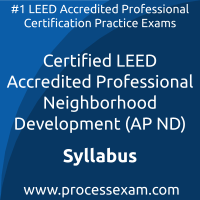 To achieve the professional designation of USGBC LEED Accredited Professional Neighborhood Development from the USGBC, candidates must clear the AP ND Exam with the minimum cut-off score. For those who wish to pass the USGBC LEED Accredited Professional Neighborhood Development certification exam with good percentage, please take a look at the following reference document detailing what should be included in USGBC LEED AP ND Exam preparation.
To achieve the professional designation of USGBC LEED Accredited Professional Neighborhood Development from the USGBC, candidates must clear the AP ND Exam with the minimum cut-off score. For those who wish to pass the USGBC LEED Accredited Professional Neighborhood Development certification exam with good percentage, please take a look at the following reference document detailing what should be included in USGBC LEED AP ND Exam preparation.
The USGBC AP ND Exam Summary, Sample Question Bank and Practice Exam provide the basis for the real Certified LEED Accredited Professional Neighborhood Development (AP ND) exam. We have designed these resources to help you get ready to take USGBC LEED Accredited Professional Neighborhood Development (AP ND) exam. If you have made the decision to become a certified professional, we suggest you take authorized training and prepare with our online premium USGBC LEED Accredited Professional Neighborhood Development Practice Exam to achieve the best result.
USGBC AP ND Exam Summary:
| Exam Name | USGBC LEED Accredited Professional Neighborhood Development |
| Exam Code | AP ND |
| Exam Fee |
Combined exam: $550 ($400 for USGBC members) Specialty only: $350 ($250 for USGBC members) |
| Exam Duration | 120 Minutes |
| Number of Questions | 100 |
| Passing Score | 170 out of 200 |
| Format | Multiple Choice Questions |
| Schedule Exam | USGBC |
| Sample Questions | USGBC LEED AP ND Exam Sample Questions and Answers |
| Practice Exam | Certified LEED Accredited Professional Neighborhood Development (AP ND) Practice Test |
USGBC LEED Accredited Professional Neighborhood Development Syllabus Topics:
| Topic | Details |
|---|---|
| LEED Process (13 Questions) |
- LEED interpretations
- Components of a LEED scorecard - Project boundary/context; LEED boundary; pre-project conditions; site vicinity; previously developed - Prerequisites and/or minimum program requirements for LEED certification - Knowing the evolutionary characteristics of LEED (e.g., development cycles of the rating systems; continuous improvement) - Integrative process (e.g., roles and responsibilities; facilitating collaboration) - Ways to earn Innovation credits:
- Identifying development program; nonbuildable and buildable land; building/street frontage
|
| Smart Location & Linkage (21 Questions) |
- Preferable locations:
- Sensitive feature avoidance:
- Site design and development: habitat and water body design, restoration, and long- term conservation
|
| Neighborhood Pattern & Design (23 Questions) |
- Community resources:
- Compactness:
- Diversity:
|
| Green Infrastructure & Buildings (21 Questions) |
- Infrastructure:
- Buildings:
- Site design and development:
|
| Project Surroundings and Public Outreach (7 Questions) |
- Planning process and local framework (e.g., land use change amendments; public hearings; zoning; transportation)
- Government agencies (e.g., Environmental Protection Agency [EPA]; FEMA; HUD; USDA; local/state agency equivalents) |
Both USGBC and veterans who’ve earned multiple certifications maintain that the best preparation for a USGBC AP ND professional certification exam is practical experience, hands-on training and practice exam. This is the most effective way to gain in-depth understanding of USGBC LEED AP ND concepts. When you understand techniques, it helps you retain USGBC LEED Accredited Professional Neighborhood Development knowledge and recall that when needed.
